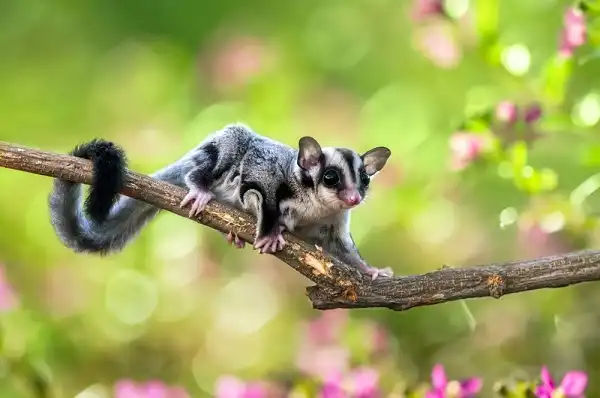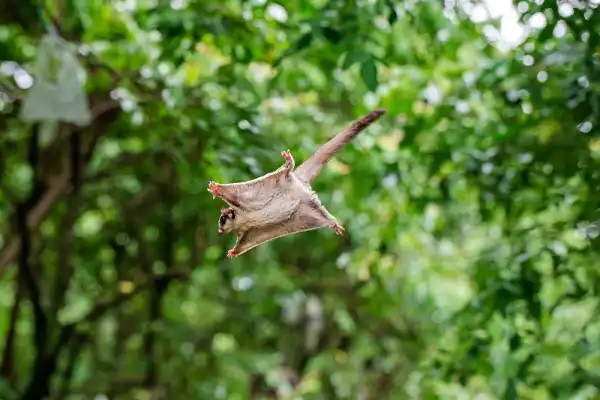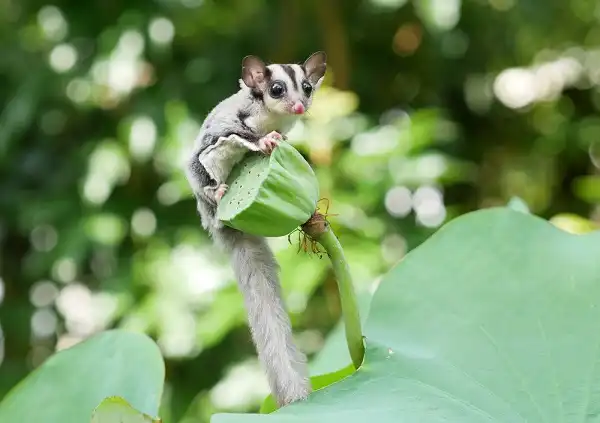Have you ever heard of a Sugar Glider? If not, your curiosity is about to be rewarded! A Sugar Glider is the name for a small marsupial native to parts of Australia and Papua New Guinea. They are incredibly unique animals with many remarkable characteristics that make them amazing pets for those who can care for their special needs. From their strong bond with humans to their ability to glide through the air, these fascinating creatures leave even experienced animal enthusiasts in awe. Read on to learn more about the incredible Sugar Glider!

Sugar Glider Description
Sugar Gliders are small marsupials. They have a unique appearance with a soft, silky fur coat of various colors including grey, tan, white, and black. Additionally, they possess a gliding membrane that stretches from their wrists to their ankles, allowing them to glide up to distances of 150 feet or more. On the face and tail, they have distinctive black markings that help them blend into their environment. In terms of behavior, Sugar Gliders are very social creatures who bond strongly with their owners when given enough time and attention. They can even learn how to use a litter box like cats!
Sugar Glider Habitat
Sugar Gliders are native to parts of Australia and Papua New Guinea, and have adapted to living in a variety of habitats. In the wild, they live in treetops and hollows, using bark and foliage for shelter from predators. They require large branches or trees to move between with their gliding membrane as well as protection from the elements. Sugar Gliders also need access to fresh fruit, sap, and insects which can only be found in close proximity to a healthy forest canopy. In captivity, Sugar Gliders require a large cage with multiple levels that allows them plenty of room to explore and climb. The enclosure should contain a variety of branches for climbing as well as hammocks or beds for nesting. The cage should also be equipped with several toys such as bells, swings, mirrors, ladders, tunnels, or chewable items like leather strips or wooden blocks.
Sugar Glider Diet
Sugar Gliders are omnivorous creatures and require a balanced diet that includes both insects and fruits. As wild animals, their natural diet consists of various insects such as crickets, mealworms, beetles, moths, grasshoppers, and waxworms. They also have an affinity for tree sap which serves as their main source of water in the wild. In captivity, owners should provide a specialized diet of fresh fruits such as apples, pears, and bananas and vegetables like sweet potatoes or squash. Additionally, they require specially formulated Sugar Glider food as well as high-quality protein sources like cooked egg whites or boiled chicken breast.
It is important to provide your pet with a variety of foods to ensure they get all the nutrients they need for optimal health. It is also recommended to offer treats such as bee pollen or other store-bought items specifically designed for Sugar Gliders. When it comes to feeding your pet Sugar Glider, consistency is key! Feeding times should remain the same each day to help establish a routine. Food dishes should be cleaned daily and fresh food should be offered daily to prevent spoilage and encourage healthy eating habits. Additionally, it is important to pay close attention to your pet’s weight in order to ensure they are consuming an adequate amount of food.

Sugar Glider Size
Sugar Gliders are small marsupials that typically measure about 6-10 inches in length, and weigh between 4-5 ounces when fully grown. They have a unique appearance with soft fur of various colors including grey, white, tan, and black. Their bodies are slender and lightweight, allowing them to easily maneuver through the air thanks to their gliding membrane which stretches from their wrists to their ankles. This membrane enables them to glide up to distances of 150 feet or more! Additionally, they have distinctive black markings on the face and tail that help them blend into their environment.
Sugar Glider Lifespan
Sugar Gliders have a relatively short lifespan of around 6-10 years in the wild and up to 15 years in captivity. In order to maximize their life expectancy, it is important to provide them with proper nutrition, exercise, and mental stimulation. They also require regular veterinary checkups and health care. The main factors that determine how long a Sugar Glider will live are diet, environment, genetics, and overall health. A healthy diet filled with fresh fruits and vegetables as well as specially formulated sugar glider food is essential for providing the necessary nutrients they need to stay strong and healthy. Additionally, providing a stimulating environment with plenty of toys and activities will keep them active both physically and mentally which will help extend their lifespan. Genetics can also play a role in determining how long a Sugar Glider will live since some individuals may be predisposed to certain conditions that can shorten their lifespan. Finally, regular checkups from a veterinarian will help ensure your pet is getting the best possible care so they can lead happy and healthy lives.
Sugar Glider Behavior
Sugar Gliders are incredibly social animals that bond strongly with their owners when given enough love and attention. They live in communities of up to 24 individuals, so it is important to keep them in pairs or groups if possible. When kept as pets, they can also learn how to use a litter box like cats do! They love to play and explore their environment, making excellent climbers due to their innate curiosity. It is important to provide your pet with plenty of toys for them to explore safely indoors. Sugar Gliders have an array of communication techniques such as barking, chirping, and squeaking that they use among themselves and with their owners. This helps establish strong bonds between family members, as well as alerting each other of potential dangers or areas of interest. Additionally, these creatures have a unique way of expressing affection which involves licking each other’s faces!

Sugar Glider Speed
Sugar Gliders are incredibly agile and fast, able to reach speeds of up to 25 miles per hour in short bursts. They have a gliding membrane that stretches from their wrists to their ankles which allows them to glide up to distances of 150 feet or more. Additionally, they can leap up to 6 feet in the air! Their agility and speed are largely due to their strong hind legs and tail which help them maneuver quickly and effortlessly through the air. Additionally, they have an impressive set of claws that help them climb trees and other surfaces with ease. Sugar Gliders also have a unique way of running; rather than trotting or galloping like four-legged animals, these marsupials use all four limbs simultaneously while running for maximum efficiency!
Sugar Glider Hunting
Sugar Gliders are excellent hunters, using their sharp claws and impressive speed to capture unsuspecting prey. They hunt mainly at night, utilizing their excellent eyesight to spot potential food sources such as insects, small lizards, birds, or rodents. They also have an acute sense of smell which helps them find food in even the darkest of environments. When hunting, Sugar Gliders will use their gliding membrane to jump from branch to branch in search of prey. Once they have located a target, they will rapidly pounce on it and pin it down with their powerful hind legs and claws before consuming it whole. In the wild, Sugar Gliders are opportunistic eaters, meaning they will consume whatever is available. However, they tend to prefer sweet fruits such as apples and bananas when given the choice. This diet can be supplemented with commercially prepared glider food containing proteins and other essential nutrients for optimal health and longevity.
Sugar Glider Common Health Issues
Sugar Gliders can be prone to certain health issues due to their small size and active lifestyle. Common ailments include skin infections, dental problems, intestinal parasites, and other conditions related to poor nutrition. It is important to provide your pet with a healthy diet of fresh fruits and vegetables as well as specially formulated sugar glider food in order to maximize its health and lifespan. Additionally, regular checkups from an experienced veterinarian are essential for maintaining your pet’s well-being. Skin infections are a common problem for Sugar Gliders due to their natural grooming habits. They often groom each other which increases the chances of passing bacteria or parasites between one another.
If these infections go untreated they can cause more serious issues such as fur loss or scaly patches on the skin. To prevent this, it is important to keep their living environment clean and free of any potential contaminants that could cause infection. Dental disease is another common ailment amongst Sugar Gliders since they rely heavily on their teeth for eating and grooming. As they age, their teeth can become worn down which can lead to problems such as cavities or gum disease if left untreated. Regular checkups from a qualified veterinarian are essential for keeping an eye out for any underlying dental issues before they become serious problems.

Sugar Glider Breeding and Reproduction
Sugar Gliders are capable of breeding and reproducing from as early as 6 months old. The breeding season typically lasts from May to July and females will give birth to their young after a gestation period of 16 days. Litters usually consist of two pups but can range anywhere from one to four pups depending on the individual female’s biology. In the wild, Sugar Gliders usually mate monogamously with a single partner throughout the mating season. During this time they create an elaborate courtship ritual that involves licking each other’s faces and chattering in synchrony while jumping around branches in an effort to attract potential mates.
The young are born blind and completely dependent on their mother for nourishment until they are ready to be weaned at 8-10 weeks old. At this stage, they are able to feed themselves on their own, though they still require protection from predation until adulthood. Males reach sexual maturity at 6-8 months and females at 9 months, making them capable of reproducing well before one year old if given the opportunity to do so. It is important for owners who wish to breed their Sugar Gliders to ensure that both partners are healthy adults free from any health issues or genetic defects before engaging in any type of reproduction activity.
Conclusion
Sugar Gliders are unique marsupials with incredible hunting abilities and a strong need for social interaction. With proper care and attention, they can make amazing lifelong companions capable of forming powerful bonds with their owners. They have special dietary requirements to ensure optimum health as well as a breeding season that typically runs from May to July. Proper precautions must be taken before attempting to breed Sugar Gliders in order to avoid any potential health or genetic issues that could arise from the process. Overall, Sugar Gliders make fantastic pets when given enough love and attention!
Frequently Asked Question


